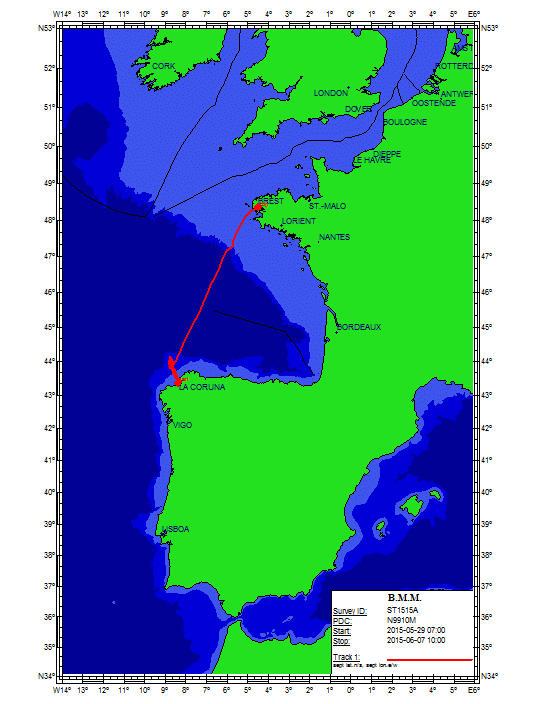Campaña: BE2015/15
FWO MINIMOUND Project: Using Cold-water coral mini-mounds as analogue for giant mound growth: assessment of environmental drivers and anthropogenic impact
Cold-water corals (CWC) are found along the entire north-eastern Atlantic Margin from Norway to the Gulf of Cadiz. In the Porcupine Seabight, these coral reefs (mainly Lophelia pertusa and Madrepora oculata) accumulate into large mounds of up to 250m high (e.g. Challenger Mound), which have been well studied over the past two decades (Roberts et al., 2006). The detailed mechanism of the start-up phase of such large CWC mounds is however not yet fully understood. Therefore, it is essential to study analogues of these stages that are not well recorded in larger mounds. The FWO MINIMOUND project (2013-2016) aims to investigate the initiation, growth and demise of small CWC mounds and to determine the role of climatic and hydrocarbon-seepage related processes as well as anthropogenic impact. This high-resolution multidisciplinary study will focus on three minimound provinces along the Biscay continental margin: (1) the Explorer and Dangeard Canyons on the Celtic Margin (Fig. 1; Stewart et al., 2013), (2) the Guilvinec Canyon on the Armorican Margin (De Mol et al., 2011) and (3) the Upper Ferrol Canyon on the Cantabrian Margin (Fig. 1). These minimounds are fossil (9.7 ka BP) and occur at relative shallow depth on the interface between the Eastern North Atlantic Central Water (ENACW) and the Mediterranean Outflow Water (MOW). Contrastingly, most present-day living CWC reef habitats dwell in the deeper MOW depth range, relying on the density and dynamics of this water mass for their food supply.
 
The objectives of the project are threefold: (1) the establishment of a chronostratigraphic framework and the reconstruction of palaeoceanographic changes over the last 15.000 years in order to determine the impact of glacial to interglacial climate change on the ENACW-MOW interface and the CWC habitats (Frank et al., 2011); (2) the minimound province at the Upper Ferrol Canyon shows a close association with hydrocarbon-seepage (pockmarks) which allows to assess the role of hydrocarbon related processes in CWC mound formation; (3) the potential impact of anthropogenic fisheries activities will be investigated.
These objectives will be tackled through a coupled geophysical, sedimentological and integrative approach, including the palaeoceanographic and biogeochemical study of sediment cores in cooperation with the BGS (UK), LSCE (Gif-sur-Yvette, France), IFREMER (France), IGME (Spain) and IEO (Spain). This Belgica2015/15 cruise is the second campaign of the project and it aims to sample both on-mound as off-mound sites by means of a 4.5 m vibrocorer (Supplied by the British Geological Survey, BGS). The target site are located on the upper slopes of the Ferrol Canyon (Cantabrian margin, Spanish EEZ) and the Guilvinec Canyon (Armorican margin, French EEZ) between 200 and 600 m water depth. In each sector, a minimum of 3 days of activities will be scheduled. In case of bad weather on 1 sector, the program will be revised towards the other sector. With respect to the size of these mounds, the coring location of the vibrocorer will be steered by means of am IXSEA USBL GAPS system. During night-time, the seafloor will be visually characterized using a small and light-weight camera dropframe (University of Plymouth).
|
|
. Campaña: BE2015/15. http://datos.ieo.es/geonetwork/srv/api/records/urn:SDN:CSR:LOCAL:SI29201505290 |
Simple
- Título alternativo
- Referencia IEO: BSH20153148
- Fecha ( Creación )
- 2015-06-07
- Identificador
- urn:SDN:CSR:LOCAL:BSH20153148
Orígen
Orígen
Orígen
- Estado
- Terminado
Punto de Contacto
Punto de Contacto
- GEMET - INSPIRE themes, version 1.0 ( Tema )
-
- Oceanographic geographical features
- Ten-degree Marsden Squares ( marsden_square )
-
- 145
- SeaDataNet Ports Gazetteer ( departure_place )
-
- A Coruña
- SeaDataNet Ports Gazetteer ( arrival_place )
-
- Brest
- International Standards Organisation countries ( departure_country )
-
- Spain
- International Standards Organisation countries ( arrival_country )
-
- France
- ICES Platform Codes ( platform )
-
- Belgica
- SeaVoX Platform Categories ( platform_class )
-
- research vessel
- SeaVoX salt and fresh water body gazetteer ( Lugar )
-
- Atlantic Ocean
- Limitación de uso
- Not applicable
- Restricciones de Acceso
- Restricted
- Otras limitaciones
- Idioma del metadato
- Spanish; Castilian
- Codificación
- utf8 UTF8
- Categoría temática
-
- Océanos
))
))
- Fecha de inicio
- 2015-05-29T00:00:00Z
- Fecha de finalización
- 2015-06-07T00:00:00Z
- Identificador del Sistema de Referencia
-
World Geodetic System 84
- Título alternativo
- L10
- Fecha ( Revisión )
- 2011-03-03
- Edición
- 3
- Identificador
- https://www.seadatanet.org/urnurl/SDN:L10
- Formato de la distribución
-
- XML (1 )
- Recurso en línea
-
Base de datos internacional con información de campañas desde 1873 hasta la actualidad. La presente campaña la podrás encontrar como BE2015/15.
SeaDataNet - CRS inventory
- Recurso en línea
-
Descubre si hay datos de esta campaña disponibles, utilizando para ello la etiqueta BE2015/15 en el buscador de datos de SeaDataNet.
SeaDataNet - CDI inventory
- Jerarquía
- Campaña/Survey Campañas
Conformidad del Resultado
- Fecha ( Publicación )
- 2010-12-08
- Explicación
- See the referenced specification
- Aprobado
- true
Conformidad del Resultado
- Fecha ( Publicación )
- 2010-12-08
- Explicación
- See the referenced specification
- Aprobado
- true
- Declaración
- El Centro de datos aplica controles de calidad estandarizados a todos los datos de los que es responsable. Contacta con el Centro de datos para más información.
gmd:MD_Metadata
- Identificador del fichero
- urn:SDN:CSR:LOCAL:SI29201505290 XML
- Idioma del metadato
- Spanish; Castilian
- Codificación
- utf8 UTF8
- Jerarquía
- Campaña/Survey Campañas
- Nombre del nivel de jerarquía
- Cruise Summary record
- Fecha
- 2021-11-29
- Nombre estándar del metadato
- ISO 19115/SeaDataNet profile
- Versión estándar del metadato
- 1.0
 Catálogo de datos del IEO
Catálogo de datos del IEO

